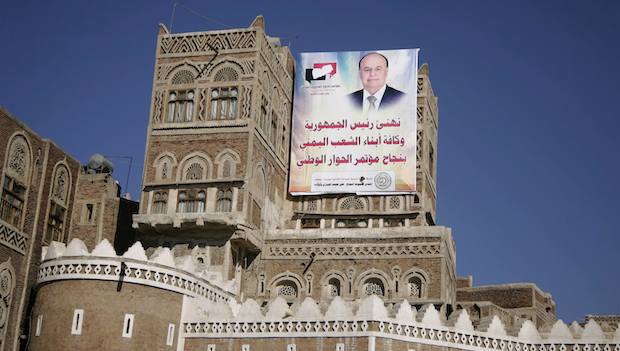
A poster of Yemen’s President Abd-Rabbu Mansour Hadi is seen on a house in Sana’a on February 1, 2014. (REUTERS/Khaled Abdullah)
If reports are to be believed, the United Yemeni Republic will be the new name of the Republic of Yemen when the country becomes a federal state, as it is expected to in the near future.
Federalism is now touted by the international community and by the Yemeni government alike as the solution for Yemen, enabling the country to move forward after two years of instability following the ousting of former president Ali Abdullah Saleh.
During the last few months of Yemen’s National Dialogue Conference, the issue of federalism has been a major sticking point between the various political factions present. Members of the Southern movement Al-Hirak called for a federal state that would consist of two provinces corresponding to the former North and South Yemen. In this, they were supported by the Yemeni Socialist Party, the ruling party in the former South Yemen. On the other hand, President Abd Rabbuh Mansur Hadi supports a system that would have five or six provinces, which angers many Southern separatists, who see it as a plot to divide the South. Others also see the whole idea of federalism as a plot to divide Yemen and pave the way for eventual re-separation.
In the end, a compromise was reached. Despite the early plans proposed for a federal system seeming to indicate the new provinces would not replicate the old North–South divide, it is clear they now will: Southern governorates are to be grouped into provinces only with other Southern governorates, with the same holding for Northern governorates. It appears the committee tasked with preparing the future federal state has decided there will be six provinces in all, four in the North and two in the South. Although this has still angered some members of Al-Hirak because it splits the former South Yemen into two provinces, many in the Hadhramaut region, formerly part of South Yemen, did not want to share a province with Aden and other areas in the South.
It is expected that power will be extremely decentralized in the future federal state, with the central government only controlling defense and foreign affairs. Other issues will be taken care of by the provincial governments. This is a radical change from the current structure of the country, where attempts to encourage local governance in the past were stymied by Saleh and his regime, who saw it as a dilution of their power. Although the question of provincial revenues and how they will be split with the federal government has not officially been discussed yet, it would seem the provinces will take a large share of any wealth generated within their own jurisdictions. This means the proposed Eastern Province comprising Hadhramaut, Mahra, and Socotra—resource rich, yet sparsely populated—is expected to be a wealthy one, at least in comparison to other parts of Yemen.
Of course, such radical changes to the structure of a country cannot happen overnight. The plan is for there to be a gradual transition to a full-fledged federal system, with the process beginning with the country being split into provinces, which will then gradually take over more and more powers from the federal government. Over the transitional period, elections will also be held at the provincial level.
The move towards federalism certainly has its positives. One of the central complaints that Yemenis have had over the past few decades is that the country is ruled not just from, but also by, Sana’a. Many people in places such as Aden, Tihamah and Hadhramaut feel disenfranchised, and they feel that Sana’a has been the focus for development in the country. The hope now is that federalism will bring about a change in this regard, and that the country’s wealth will be more equally distributed, without overwhelming power being situated in one group’s hands.
However, there are still those with qualms. Sure, federalism may lead to a situation where wealth and power are not concentrated in one faction, but instead we may see a situation arising where official corruption merely changes location and becomes localized. Unless the culture of corruption itself is tackled, it does not matter much what the system looks like, federal or not.
This article was originally published in The Majalla.
All views expressed in this blog post are those of the author and do not necessarily represent the views of, and should not be attributed to, The Majalla magazine or Asharq Al-Awsat newspaper.
